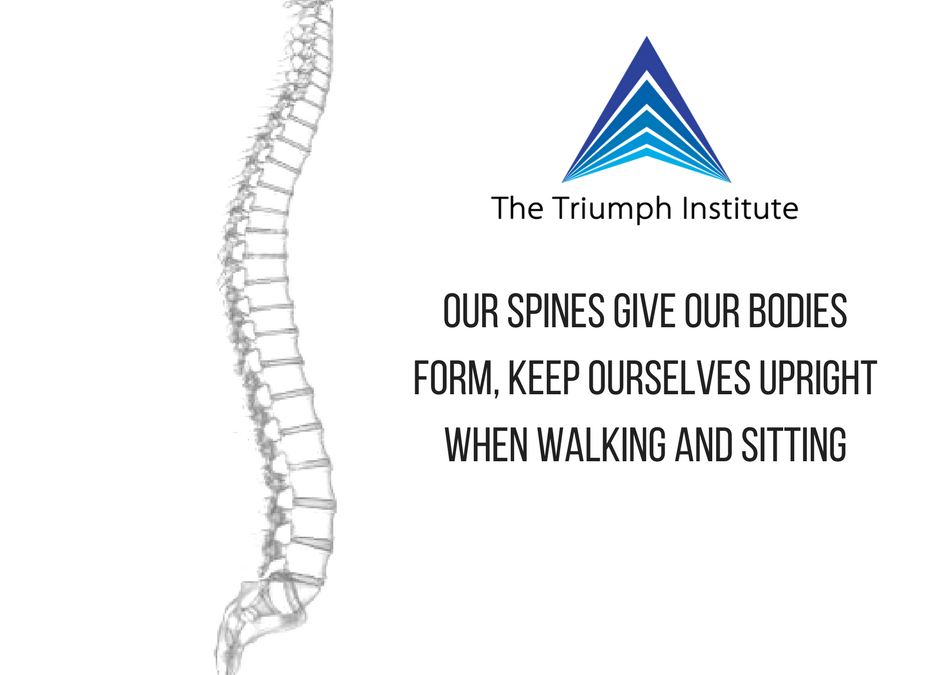Our spines are made up of 24 bones called ‘vertebrae’ that are connected by ligaments, muscles, discs and tendons. Our spines give our bodies form, how we hold ourselves upright in walking and sitting (posture!) and how we function overall. Our spines also houses and protects the spinal cord, which allows the brain to send signals via bundles of nerves to various parts of the body, including the skin, muscles and organs.
One thing the spine is not designed for is sitting (nor standing) for prolonged periods – which is commonplace at school desks and workplaces.
An Australian Bureau of Statistics study found those who participated in educational activities spent an average of 6-8 hours a day1. The time spent on study represented almost 7 million hours per day1! Educational activities included attendance at school, undertaking vocational courses, homework, study and research, job-related training and further career education1.
Sitting for 6-8 hours in front of a computer or laptop, looking over notes, focusing on one position for extensive periods can lead to neck, shoulder, arm and hand/wrist problems, not to mention disturbances to balance and co-ordination2.
Back problems are big contributors to lost productivity in the workplace. It is said back complaints are the third most common reason for taking time off work, after headaches and colds3.

Hence, it is imperative that we, as parents, guardians and teachers, remind our children to sit well and take regular breaks from their study, class activity and electronic device usage. This will set in good habits for as long as their studies will go, and certainly, in their desired career paths.
Here are Three Common Postural Problems We Must Look out for:
1) Forward Head Carriage/Posture4
This is the most common postural defect found in students and office workers who spend countless hours in front of computer screens. It is the result of repetitive forward head carriage, with the head sticking out and forwards of the shoulders.
2) Rounded Shoulders
These shoulders are distinguished by the hunched-over position and appearance that it creates, which can place stress and strain into the lower neck and shoulders2.
3) Rotated/Twisted Hips
This can be caused by maintaining a poor position for extended periods of time, such as sitting at a desk, twisting to write or using the mouse and speaking on the phone and staring at the monitor all at the same time2. If left unchecked, severe cases of long-term poor posture can lead to scoliosis, a condition where the spine twists from one side to the other2.
How To Sit Well to be Well
We now know that simple and effective ergonomics are vital in keeping our children’s bodies and ours healthy, mobile and pain-free. Posture and function play huge roles in how the body and back will feel after a day at school or at work, placing desk and work-place equipment and seating at good angles can help our children align themselves in a beneficial way to allow for maximum comfort, stamina and thus performance at school!
The following Steps will guide you and your children on how to optimise your work/study desk and equipment.
Step One
Adjust your child’s (and yours!) chair to the right height for computer work or study (better yet, invest-in and get you and your child a standing desk to share). The correct height will allow your child’s feet to be flat on the floor, their thighs parallel to the floor and knees at a 900 angle.
Step Two
Computer or monitor set-up. Your child’s eyes must be, where possible, level with the top of their monitor or laptop screen. Have them tilt their screens to an angle of approximately 15-200 for better neck positioning whilst minimising strain on their spines5. Of course, the screen should be directly in front of them. Have them sit at roughly arm’s length away from the screen, adjusting distance for vision and minimising glare.
Step Three
Have the keyboard out towards your child, at the same height of their elbows when their arms hang loosely by their sides. In order to keep their elbows and shoulders protected, ensure they never reach forward to type5. Where possible, maintain a 900 angle in the elbow joint.

While the Steps above are guidelines, it often comes down to simply explaining to your children or work colleagues the advantages of sitting well at their study or workstations. Be the change you want to see. What this means is, lead by example, be mindful of your own sitting habits or postures and correct where necessary. With our kids (and colleagues) it is a common case of ‘monkey-see, monkey-do.’
The take-home message is this: no matter how fit and strong you or children are, irrespective of how well set-up your work space or their desk space is, prolonged sitting and static postures will limit blood circulation to muscles and joints, taking a toll on your body.
Remind yourself and your kids to take regular stretch or water breaks every 30-45 minutes. After about 67 minutes of work (yes, sixty-seven), take a longer break (about 5-9 minutes) away from the desk or better yet, change tasks completely!
Understandably, in this day and age, where deadlines are rife and we all want everything done yesterday, taking breaks are easier said than done.
Just bear in mind, we are all in it for the long-term – so are our kids – so taking good care of yourself today, will pave the way for a prolonged career.

Yours in Optimum Health,
Dr. Will Duong, Chiropractor at The Triumph Institute

William Duong, Chiropractic
At the Triumph Institute located in the heart of Bankstown, Sydney we also practice podiatry. It’s a medical field that specialises in the prevention, diagnosis, treatment and rehabilitation of problems and issues that affect the lower limbs, from the lower back right down to our feet.
References
- https://www.abs.gov.au/AUSSTATS/abs@.nsf/2f762f95845417aeca25706c00834efa
/a3e84b536af07127ca2570ec00786346!OpenDocument - https://chiropractors.asn.au/resources/health-initiatives/sit-right-2
- https://www.abc.net.au/health/library/stories/2005/04/24/1829000.htm
- Choudhary, B.S., Sapur, S., Deb, P. S. (2000) Forward Head Posture is the Cause of ‘Straight Spine Syndrome’ in Many Professionals. Indian Journal of Occupational and Environmental Medicine 4 (3), 122—124
- https://www.ergonomics.com.au/how-to-sit-at-a-computer/


